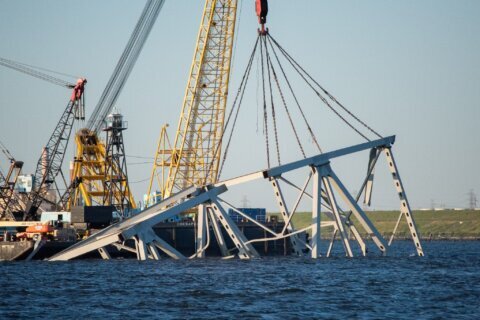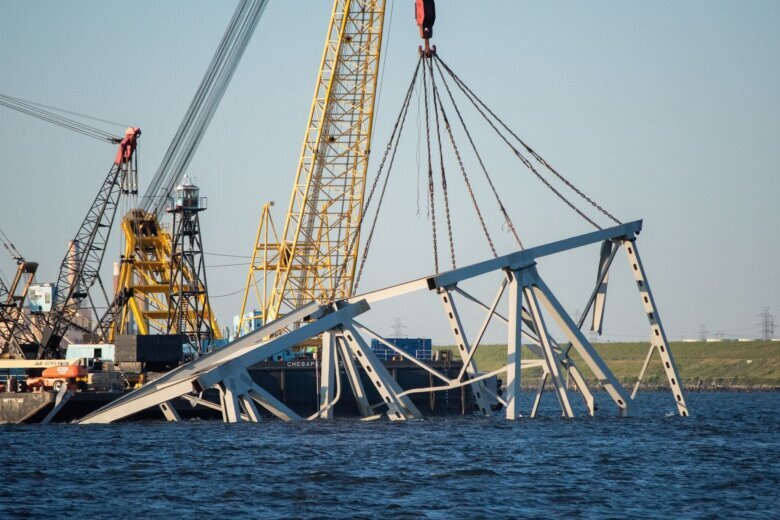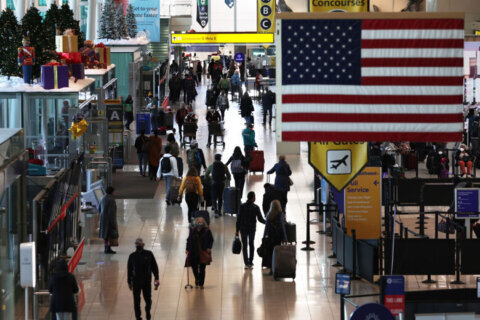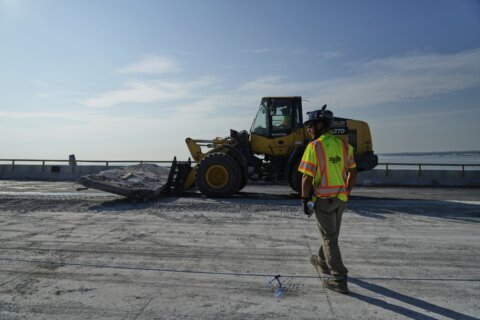Read more about the latest on the Key Bridge collapse and recovery in Baltimore.

It’s been two months now since a huge container ship slammed into Baltimore’s Key Bridge causing most of it to collapse into the water and killing six construction workers. Crews continue to remove giant pieces of the Maryland bridge from the bottom of the Patapsco River with hopes of reopening the channel to all commercial ships by mid-June.
Workers have been using specialized cranes to pull out pieces of the bridge that weigh about 500 tons a piece since last Friday.
Col. Estee Pinchasin, the Baltimore District Commander for the Army Corps of Engineers, joined WTOP anchors Shawn Anderson and Anne Kramer live to discuss the latest on the cleanup efforts.
Listen to the interview or read the full transcript below.
Anne Kramer: Good to have you back on, Colonel. Crews have been really busy the last few days. Please tell us what’s happening with getting those giant pieces of the bridge from the bottom of the river.
Col. Estee Pinchasin: Well, good afternoon, Anne, Shawn, great to be here with you. They’ve been making great progress. We’re down to one big piece of truss that you can see that’s left in the water. What you were able to see after the Dali left was the remainder of that one span that was laying on top of the Dali. Ever since the Dali departed, you were only able to see about a third of what was above the surface. And they’ve since then removed two of the three large sections of that truss, and we’re down to the last one, which will hopefully be done today.
Shawn Anderson: Colonel, remind us again why it’s so important for all the wreckage and all the pieces of that bridge, despite the size, to be removed before the full shipping channel can reopen.
Col. Estee Pinchasin: So just to remind everybody, once we opened a limited access channel, at first, we opened it at 300 feet wide and 35 feet deep. We’re now at 400 feet wide and 50 feet deep. With that depth and width, we’re able to bring in any vessel that used to call in the Port of Baltimore. But we want to get it all the way out to 700 feet and down to full 50 feet deep all the way across so that if we did need two-way traffic, we’d be able to support that. I think what you’re talking about, Shawn, is that even after we get down to 50 feet of depth, we’re still going to have some equipment out there pulling wreckage from the bottom of the riverbed. There’s steel that’s below the mud line, that is down below the surface of the riverbed, that we don’t want to leave behind so that when we come through with a regular maintenance dredging that Baltimore District maintains now for about 107 years, we want to make sure that nothing is left behind.
Anne Kramer: Colonel, explain for us what June 8 to June 10 is about — that’s a key date for the recovery in all of this.
Col. Estee Pinchasin: We’re hoping that — well, I think it’s not even just hoping anymore, we’re fairly certain — that we will have that Fort McHenry Channel, that main shipping channel, completely cleared 700 feet across and 50 feet deep, restoring it to its original dimensions for safe navigation, removing all hazards to navigation at that depth. But like I said, we’ll still have some more work to do to make sure that nothing is left behind.
Shawn Anderson: And once that full shipping channel reopens, what will be the role of your crew when it comes to the cleanup at the site?
Col. Estee Pinchasin: Well, once we remove everything that’s below the mud line, we will be continuing to maintain the federal navigation channels in and out of the Port of Baltimore. Baltimore District maintains about 90 federal channels in and around this area, all the way through in the Chesapeake Bay Area. We maintain those year-round. I don’t know that people realize that all the time. But we will be dredging this channel for any of the shoaling that accumulated over the last three years. The last time we dredged it was in fiscal year ’22 and we’ll be dredging it in fiscal year ’25, which is right around the corner.
Anne Kramer: Colonel, in our last question here, we know two months have now passed since the tragedy happened and since the collapse of most of the Key Bridge. How surprised are you that everything is able to be done as quickly as it has been?
Col. Estee Pinchasin: I didn’t know what to expect at first because I’ve never worked on salvage operations. So I really was relying on our experts — which, thank God we brought them in — from the Navy Supervisor of Salvage, and then our salvage industry partners. For me, the biggest achievement and the greatest accomplishment — not just for me, for the whole team — was recovering our six Marylanders, those six construction workers, and returning them to their families. I am so thankful that we were able we were able to do that and continue to make progress at this pace with everyone working safely, no injuries. To me, that’s really the greatest accomplishment, so hats off to that whole team.
Get breaking news and daily headlines delivered to your email inbox by signing up here.
© 2024 WTOP. All Rights Reserved. This website is not intended for users located within the European Economic Area.








